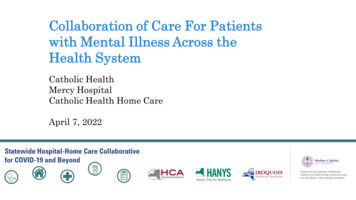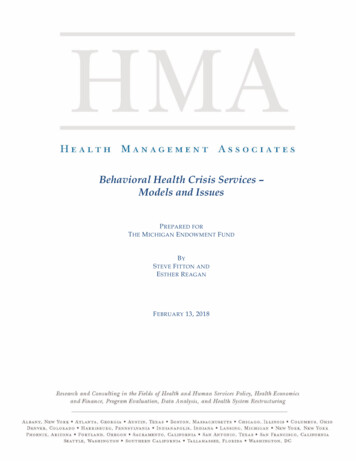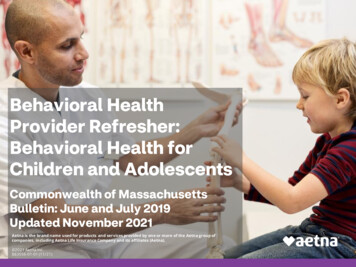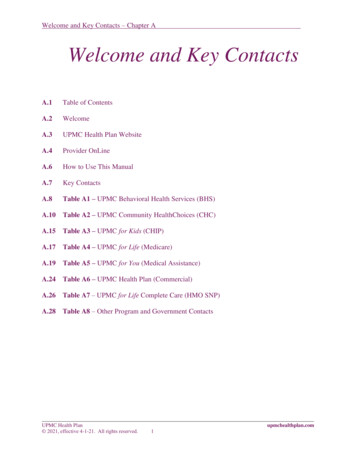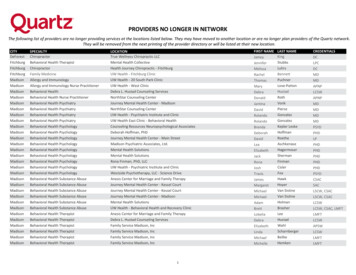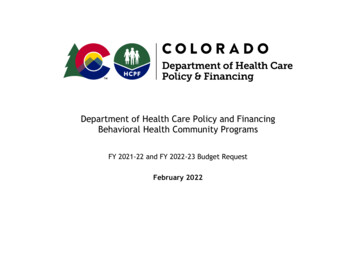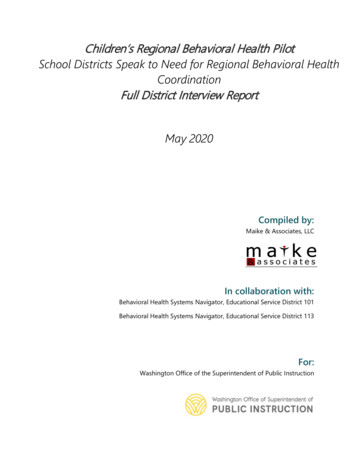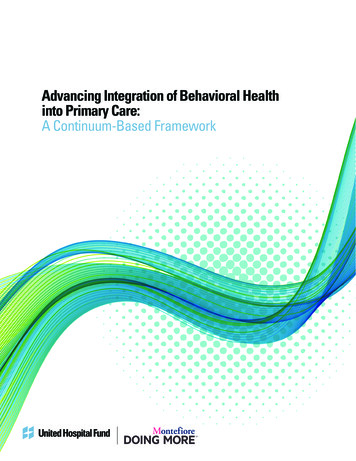
Transcription
Advancing Integration of Behavioral Healthinto Primary Care:A Continuum-Based Framework
Advancing Integrationof Behavioral Health intoPrimary Care:A Continuum-BasedFrameworkHenry Chung, MDCare Management Organization,Montefiore Health SystemNina Rostanski, MPHGovernment and Community Relations,Montefiore Health SystemHope Glassberg, MPAStrategic Initiatives and Policy,HRHCare Community HealthHarold Alan Pincus, MDDepartment of Psychiatry,Columbia University andNewYork-Presbyterian Hospital
Copyright 2016, United Hospital Fund1411 Broadway, 12th Floor New York, NY 10018-3496 T: 212.494.0700 F: 212.494.0800 www.uhfnyc.org
ContentsAbout This FrameworkiiiExecutive SummaryivIntroduction1 e Case for Integration1New York’s Reform Efforts1Building the Framework2An Evidence-Based Framework for Primary Care–Behavioral Health Integration3How the Framework Facilitates Practice Integration3Structure of the Framework: Key Components of Integrated Care4Figure: Elements of the Framework4Structure of the Framework: e Integration Continuum7Sidebar: Moving Along the Continuum8Using the Framework9Checklist: Implementing Behavioral Health Integration9Getting Started: Managing Change10 e Framework Step by Step10Sidebar: Using the Framework in the Context of New York’s Reform Efforts12Observations and Conclusions13References15AppendicesA. Supportive Literature19B. Key Stakeholders Providing Input for Framework Development21C. Evidence-Based Framework for Primary Care–Behavioral Health Integration22D. Resources on Primary Care–Behavioral Health Integration24E. Behavioral Health Integration Readiness Assessment25F. Resources on New York State Regulations31
About This FrameworkAdvancing Integration of Behavioral Health into Primary Care: A Continuum-Based Frameworkaddresses one of the major challenges inherent in transforming today’s primary care into a system ofhigh-quality “advanced primary care.” e need to bring high-quality treatment and management ofdepression, anxiety, and other common behavioral health conditions into primary care has been welldocumented. But what is less clear has been how to accomplish that at scale, given the varying typesof primary care practices and, in particular, the resource limitations of small and medium-sizepractices and the complexity of the models that are currently the evidence-based standards forintegrating medical and behavioral care. is framework seeks to fill that gap by delineating a series of steps that providers can take to movetoward integration of behavioral health services into their primary care practices. It is the result ofwork conducted, with grant support from United Hospital Fund, by a team headed by two leaders inthis field: Henry Chung, MD, vice president of the Care Management Organization of MontefioreMedical Center, medical director of Montefiore’s Accountable Care Organization, and associateprofessor of clinical psychiatry at the Albert Einstein College of Medicine, and Harold Pincus, MD,professor and vice chair of the Department of Psychiatry and co-director of the Irving Institute forClinical and Translational Research at Columbia University. e framework is an example of strategic grant making that builds on UHF’s focus areas and programactivities, including ongoing efforts, through its Innovation Strategies Initiative, to improve theperformance of New York’s health care system, and to integrate behavioral health into primary care.Montefiore Health System is one of New York’s premier academic health systems and is a recognizedleader in providing exceptional quality and personalized, accountable care to approximately threemillion people in communities across the Bronx, Westchester, and the Hudson Valley. It is comprisedof 10 hospitals, including the Children’s Hospital at Montefiore and Burke Rehabilitation Hospital,and close to 200 outpatient care sites. e advanced clinical and translational research at its medicalschool, Albert Einstein College of Medicine, directly informs patient care and improves outcomes.From the Montefiore-Einstein Centers of Excellence in cancer, cardiology and vascular care,pediatrics, and transplantation, to its preeminent school-based health program, Montefiore is a fullyintegrated health care delivery system providing coordinated, comprehensive care to patients andtheir families. For more information please visit www.montefiore.org. Follow us on Twitter and viewus on Facebook and YouTube.United Hospital Fund is an independent, nonprofit organization working to build a moreeffective health care system for every New Yorker. For news, commentary, publications, andadditional information on our initiatives, visit www.uhfnyc.org.ADVANCING INTEGRATION OF BEHAVIORAL HEALTH INTO PRIMARY CARE: A CONTINUUM-BASED FRAMEWORKiii
Executive SummaryDespite significant prevalence, behavioral health conditions frequently go undiagnosed anduntreated. Primary care providers can play a significant role in both diagnosing andfacilitating treatment of these conditions, making increasing capacity for treatment ofbehavioral health conditions in primary care settings a core strategy for improving access toand quality of care. Recognizing the importance of this approach, New York State hasprioritized implementation of behavioral health integration models through both theMedicaid Delivery System Reform Incentive Payment (DSRIP) program and the emergingAdvanced Primary Care (APC) model.Although evidence-based integration models work well when implemented properly, therehas been relatively little guidance on the underlying steps primary care practices can take tobuild toward more advanced models, including how smaller and medium-sized practices, inparticular, can accomplish integration objectives given resource constraints.Based on a targeted literature review and input from diverse stakeholders, the frameworkpresented in this guide seeks to provide primary care practices, as well as DSRIP PerformingProvider Systems (PPSs) and other organizing entities, with practical guidance onincremental steps to achieve and advance key elements of integrated care for all types ofprimary care practices.An Evidence-Based Framework for Primary Care–Behavioral Health Integration e framework presented in this guide is intended to help practices initiate and developoperational plans to achieve effective, evidence-based integration. e framework lays outon the vertical axis key components of integrated care across integration models, groupedinto eight broad domains (see Appendix C). ese domains are: Case finding, screening, and referral to care; Use of a multi-disciplinary professional team—including patients—to provide care; Ongoing care management; Systematic quality improvement; Decision support for measurement-based, stepped care; Culturally adapted self-management support; Information tracking and exchange among providers; Linkages with community/social services.ADVANCING INTEGRATION OF BEHAVIORAL HEALTH INTO PRIMARY CARE: A CONTINUUM-BASED FRAMEWORKiv
Building upon existing literature and stakeholder input, the framework identifiespreliminary, intermediate, and advanced representations of each component along thehorizontal axis. e rows of the framework represent parallel paths toward integration thatcan be moved along at different speeds, following a series of incremental steps or guideposts.Conveying a sense of movement and momentum, the framework’s continuum allows practicesto place themselves along the pathway and identify their status within each domain, ratherthan rigidly anchoring practices to a specific level of integration across domains. e eightdomains of the framework allow practices to increase their capabilities in different aspectsof integrated care at different rates, based on resources and practice structure.Using the Framework e framework, as outlined briefly below, provides a way for practices to organizethemselves based on existing strengths while developing resources to advance theirintegration. Specifically, we recommend that practices initially use the framework to assesstheir current state of integration and develop future-state goals. Recognizing that there islatitude on how to advance specific integration components, the framework aims to providea roadmap for practices to make investments in time, training, workforce, and resourcesthat are necessary to improve the implementation of integration and patient care. However,a practice’s individual characteristics will influence its goals, making achieving the mostadvanced state of each domain and its components not necessarily the ultimate target forevery practice.A Checklist for Implementing Behavioral Health IntegrationGETTING STARTED: MANAGING CHANGEq Establish commitment from senior leadership and identify practice champions.THE FRAMEWORK STEP BY STEPq Assemble an appropriately staffed team to assess the current state of integration.q Perform a self-assessment, using data to determine current status of practice ineach of the components and subcomponents of the framework.q Perform an environmental scan to identify potential external resources forfacilitating integration efforts.q Prioritize domains for change.q Set specific, measurable, and achievable 3- to 12-month goals for each componentof the framework.q Assess existing and necessary resources for achievement of integration goals,including capital investments, personnel, and technology costs.q Assess attainability of goals to ensure they are realistic and appropriate.ADVANCING INTEGRATION OF BEHAVIORAL HEALTH INTO PRIMARY CARE: A CONTINUUM-BASED FRAMEWORKv
Observations and Conclusions rough ongoing New York State initiatives, there are meaningful opportunities to changethe way that behavioral health services are delivered in primary care; however, challengesremain. While this framework offers operational guidance for increasing integration ofbehavioral health care into primary care, there are external considerations not addressedhere that will shape pathways to integration, including regulation, reimbursement,workforce, and other policy issues. Finally, the practice transformation described in thisframework requires a fundamental change in practice culture, as both the primary care andbehavioral health fields contend with significant workforce shortages in New York Stateand nationally. is framework is a work in progress, with more work needed, in particular, on developingmetrics that reflect achievement of the key components of integrated care, as well as onincentivizing movement toward increased integration. While discussions of various valuebased payment approaches are underway, it will be crucial for payers and policymakers toconsider intermediate financial incentives to help practices support movement towardincreased integration; this framework may be useful in developing these incentives,in association with measurable performance criteria. rough ongoing efforts, the authorsintend to continue to refine the framework and assess its applicability and utility in thesignificant transformation underway in New York State.ADVANCING INTEGRATION OF BEHAVIORAL HEALTH INTO PRIMARY CARE: A CONTINUUM-BASED FRAMEWORKvi
IntroductionBehavioral health disorders have a major impact on both personal health and health carecosts, yet are only diagnosed and treated in a minority of cases. Primary care providers,because of their ongoing relationships with patients, can play a significant role in bothdiagnosing and facilitating treatment of these conditions, but successfully adopting that rolerequires both culture change and systematic practice transformation. is guide offers a practical framework for integration of behavioral health care intoprimary care settings, both for individual practices and in the context of various New YorkState health reform initiatives. Organizing key components of integrated care into eightdomains arrayed along a developmental continuum, it is intended to help a variety ofprimary care practice types identify their current level of integration, begin to develop plansfor moving further along the continuum, and prioritize and implement necessary steps foreffective integration.The Case for IntegrationBehavioral health disorders, with high prevalence both in New York State and nationally,1, 2contribute to decreased quality of life 3 and can be independent risk factors for and worsenother health outcomes.4, 5 ese conditions are also associated with increased health carecosts: in some studies, health care costs for Medicaid enrollees with a behavioral healthdiagnosis were more than three times the costs for those without,6, 7 although successfultreatment has been found to reduce such costs.8, 9Despite this prevalence and burden, behavioral health conditions frequently goundiagnosed and untreated, with only 22 percent of adults with common mental healthdisorders receiving care from any type of mental health specialist in a given year.10 Evenwhen conditions are identified by primary care providers, patient engagement in specialtyreferral is low,11 with frequent patient preference for receiving treatment from providerswith whom they already have an established relationship.12, 13 ese factors make increasingcapacity for treatment of behavioral health conditions in primary care settings a corestrategy for improving access to and quality of care.New York’s Reform EffortsIn recognition of this urgent need, momentum continues to build in New York State for theintegration of behavioral health into primary care. at was, in fact, the sole“transformation” project selected by all 25 of the Performing Provider Systems (PPSs)participating in New York Medicaid’s Delivery System Reform Incentive Payment (DSRIP)ADVANCING INTEGRATION OF BEHAVIORAL HEALTH INTO PRIMARY CARE: A CONTINUUM-BASED FRAMEWORK1
program statewide.14 Under State parameters for this project, primary care practices havethe option of implementing behavioral health integration through either an enhancedco-location model or the Collaborative Care/IMPACT model described in Appendix A.15Additionally, as part of its State Innovation Model (SIM) initiative aimed at ensuring that allNew Yorkers have access to high-quality primary care using medical home principles, theState is designing a model for Advanced Primary Care (APC) that will include a progressiveset of practice capabilities and quality, outcome, and cost milestones, intended to be tied,over time, to value-based payment for all payers and all lines of business (Medicare,Medicaid, and commercial). While the model and its underlying iterations are still beingfinalized, as of publication of this guide, the integration of behavioral health services intoprimary care has been identified as a critical component. Yet with practices starting atdifferent points along a continuum and having varying resources to apply to integrationgoals, questions remain about how to define evidence-based standards that reflectachievement of behavioral health integration.In fact, although evidence-based integration models work well when implementedproperly,16, 17, 18 there has been relatively little guidance on the underlying steps primary carepractices can take to build toward more advanced models, and how smaller and mediumsized practices, in particular, can accomplish integration objectives given the significantresource constraints they sometimes face. e framework presented here, rooted in evidence on several seminal models of primarycare–behavioral health integration, seeks to provide primary care practices, as well as PPSs,health plans, accountable care organizations (ACOs), and other organizing entities, withpractical guidance on important incremental steps that can be taken to achieve and advancekey elements of integrated care. e framework may also provide insights for statepolicymakers and payers on how to assess and potentially support movement toward moreadvanced integration in conjunction with current reform initiatives—including guidance forhelping small and medium-sized practices adopt DSRIP and APC model elements.Building the Framework is framework focuses on integration of behavioral health into primary care settings foradult patients; it does not address models focused on pediatric settings or integration ofprimary care into behavioral health settings (reverse integration). Although most of theliterature on integrated care has focused on its impact on depression and anxiety conditions,we believe that the framework’s elements may also apply to other behavioral healthconditions commonly found among adult primary care patients, including substance use,ADVANCING INTEGRATION OF BEHAVIORAL HEALTH INTO PRIMARY CARE: A CONTINUUM-BASED FRAMEWORK2
since the core principles of screening, intervention, and follow-up have been shown toimprove outcomes in those conditions as well.19, 20, 21To prepare the framework, the authors performed a targeted literature review (see AppendixA) and conducted 12 semi-structured interviews with key informants from across New YorkState, including primary care practitioners, behavioral health specialists, PPS leads, payers,and policymakers.Feedback solicited during these interviews included perspectives on current plans,accomplishments, and challenges to integration in different practice settings, as well as inputon a dra version of the framework, including its overall approach, structure, and utility. e framework was then revised and presented to a larger group of key stakeholders at anadvisory meeting convened by United Hospital Fund to gather additional feedback,including insights on the framework’s applicability under various New York State reforminitiatives. e expert feedback from both key informants and a broader stakeholderadvisory group (see Appendix B) was crucial to the development and refinement of thecurrent version of the framework presented here.An Evidence-Based Framework forPrimary Care–Behavioral Health IntegrationHow the Framework Facilitates Practice Integration is framework is intended to help primary care practices initiate and develop operationalplans to achieve effective, evidence-based integration. It is designed to aid assessment oftheir current state of integration across a range of operational components, rather thanattainment of a particular state of readiness (i.e., coordinated stage versus integrated stage)or adherence to the Collaborative Care Model (CCM) or other paradigms, since even thosemodels’ elements vary in clinical practice. e authors anticipate that users can also employ the framework to identify goals for futurelevels of integration, component by component, and the individual steps to be taken alongthe way. We recognize that these goals are likely to be tailored to the practice environment(e.g., rural or urban, payer mix, FQHC or other type of center, hospital-based orindependent practice, etc.). Although we present preliminary, intermediate, and advancedstates for particular elements, we are not suggesting that it will make sense, in all cases, forpractices to achieve “advanced” states of all individual components.ADVANCING INTEGRATION OF BEHAVIORAL HEALTH INTO PRIMARY CARE: A CONTINUUM-BASED FRAMEWORK3
us this framework is not designed to be used as a basis for scoring practice performancefor quality assessment or reimbursement; instead, it is intended to provide a road map thatwill be helpful for a wide array of primary care settings in pursuit of common integrationgoals. We believe that practice settings vary in the elements they can “reasonably” expect toadopt, given resources, space limitations, and workforce capacity. For example, smaller,independent practices may need to aim for elements around the intermediate level—andwill likely require near-term payment incentives or direct resources to support thisevolution—while larger and well-networked practices can more quickly adopt moreadvanced elements and embedded value-based reimbursement approaches. Our perspectiveis that patients in need of behavioral health treatment will benefit from the intermediateelements associated with the framework, and that all practices working on integrationshould strive to achieve many of these elements (defined and discussed below) in order tosee meaningful quality improvements and potential cost savings.22, 23, 24, 25, 26, 27Structure of the Framework: Key Components of Integrated Care e framework presented in condensed form below and in full in Appendix C lays out onthe vertical axis key domains of integrated care that emerge in the literature acrossintegration models, including but not limited to the CCM. While a variety of studies haveThe Framework's Structure IllustratedThis condensed version of the framework—not the full working model, only a partial representation of its structure—illustrates severalof the 8 component domains and 57 steps. The complete framework, depicting all domains and steps, appears in Appendix C.Integration ContinuumAdvancedsScreening, initialassessment, andfollow-upPatient/clinician identification of those withsymptoms—not systematicSystematic screening of target populations(e.g. diabetes, CAD), with follow-up forassessmentPopulation stratification/analysis as part ofoutreach and screening, with follow-up forassessment and engagementsReferralfacilitation andtrackingReferral to external BH specialist/psychiatristEnhanced referral to outside BH specialist/psychiatrist through a formal agreement,with engagement and feedback strategiesemployedReferral and tracking through EHR oralternate data-sharing mechanism, withengagement and accountability mechanismssCoordination,communication,and longitudinalassessmentLimited follow-up of patients provided byoffice staffProactive follow-up to assure engagementor early response to careRegistry plus BH activation and relapseprevention, with assertive outreach to patients(including field-based visits) when necessarysClinical registriesfor tracking andcoordinationInformal method for tracking patient referralsto BH specialist/psychiatristPatients referred to outside BH specialist/psychiatrist with clear expectations forshared communication and follow-upRegistry integrated into EHR, includingseverity measurement, attendance at visits,and care management interventions; selectedmedical measures tracked when appropriatesNo sharing of treatment informationInformal phone or hallway exchange oftreatment information without regularchart documentationRoutine sharing of information throughelectronic means (registry, shared EHR, andshared care plans)sInformationtracking andexchange amongprovidersIntermediatesOngoing caremanagementsCase finding,screening, andreferral to carePreliminarysKey components of integrated careSharing oftreatmentinformationADVANCING INTEGRATION OF BEHAVIORAL HEALTH INTO PRIMARY CARE: A CONTINUUM-BASED FRAMEWORK4
articulated components of these models,28, 29, 30, 31, 32 this framework builds upon existingliterature and stakeholder input to integrate key elements identified in other work.We've grouped these components into eight broad domains and identified preliminary,intermediate, and advanced representations of each, along the horizontal axis. e eightdomains of the framework are:CASE FINDING, SCREENING, AND REFERRAL TO CARE. is domain encompasses steps todevelop methods and systems for identifying patients with behavioral health conditions,assessing their symptoms, and meaningfully referring them to and engaging them intreatment. Highlighting the important role of screening in the primary care context, the U.S.Preventive Services Task Force recently revised its recommendation on depression screeningto call for screening of all adults, modifying an earlier recommendation that universalscreening be implemented only when specific depression care supports were in place.33USE OF A MULTI-DISCIPLINARY PROFESSIONAL TEAM—INCLUDING PATIENTS—TO PROVIDECARE. Involvement of a multi-disciplinary team, including patients themselves, is a keychange from the usual approach to care.34 Individuals involved in the care team varydepending on a practice’s level of integration. But as the care team evolves, changes inworkflow are necessary to allow for increased contact between the primary care providerand behavioral health specialists (any providers with specialized behavioral healthtraining), to facilitate shared care planning and communication about shared patientsacross team members and disciplines.35, 36ONGOING CARE MANAGEMENT. Ongoing, proactive, relentless follow-up of patients isessential to combatting fragmentation between providers and to engaging patients in theircare.37 While tools used for tracking follow-up may vary, ongoing longitudinal assessmentand communication with patients, including a focus on both physical and behavioral health,are important aspects of an integrated approach. e literature and stakeholder feedbackboth emphasized that care management entails a set of functions, not necessarily a singleindividual.38 Additionally, evidence suggests that early initiation of follow-up and patientengagement is key for improving patient outcomes.39, 40SYSTEMATIC QUALITY IMPROVEMENT. Effective quality improvement is another key toongoing advancement in the integration of primary care and behavioral health, and animportant aspect of moving toward a population health approach.41 Essential to guidingthese efforts is the use of quality metrics encompassing both process and outcomes. DataADVANCING INTEGRATION OF BEHAVIORAL HEALTH INTO PRIMARY CARE: A CONTINUUM-BASED FRAMEWORK5
from electronic health records (EHRs) and other sources, ideally along with the attentionof designated quality improvement personnel, allow for continuous monitoring ofperformance and development of strategies for improvement.DECISION SUPPORT FOR MEASUREMENT-BASED, STEPPED CARE. Use of pharmacotherapywhen appropriate and coordination of access to some form of evidence-basedpsychotherapy—whether fully integrated into the primary care setting or through off-sitepartnerships or technology such as computerized cognitive behavioral therapy or onlinepsychotherapy—are both key parts of any approach to integrated care.42 is domain coversthe use of evidence-based guidelines and treatment protocols, including tools for ongoingsymptom monitoring and strategies for intensifying treatment for patients who do not showimprovement.43CULTURALLY ADAPTED SELF-MANAGEMENT SUPPORT. Beyond a simple focus on medicationadherence, self-management support encompasses an exchange of information that helpspatients (and their families) understand their behavioral health condition and promotesshared decision making between the patient and the primary care provider.44 is domaindescribes tools (e.g., motivational interviewing) utilized to promote patient selfmanagement through effective, culturally appropriate communication, greater patientactivation, shared goal development, and a focus on improving overall health and wellness.INFORMATION TRACKING AND EXCHANGE AMONG PROVIDERS. As the care team incorporatesadditional members, enhanced inter-professional communication is essential to breakingdown the silos that frequently exist between primary care and behavioral health services. Yettime constraints in a practice may necessitate the use of multiple methods of informationsharing, both formal and informal. is domain encompasses the development of tools forelectronically tracking and coordinating information (e.g., formal patient registries orshared EHR systems), as well as protocols for when and how information is exchanged.LINKAGES WITH COMMUNITY/SOCIAL SERVICES. Effective integrated care involves addressingthe key social determinants of health, along with behavioral health conditions.45 isdomain focuses on steps for fostering effective linkages to housing, vocational, and othersupportive social services and to community organizations and resources, and forincorporation of relevant social determinants into care plans.ADVANCING INTEGRATION OF BEHAVIORAL HEALTH INTO PRIMARY CARE: A CONTINUUM-BASED FRAMEWORK6
Structure of the Framework: The Integration ContinuumLike the CCM and other models, the eight domains described above represent the coreelements of integrated care. Unlike those models, however, we approach this not as aneither/or set of conditions—readiness or not in all domains—but as parallel paths towardintegration that can be moved along at different speeds, following a series of incrementalsteps or guideposts. at’s a critical point because many practices seeking to adoptintegration models may find that they are already actualizing the component parts of somedomains and partway there on others, or that a particular component does not make sensefor their setting (e.g., modifications may be needed for smaller primary practices in whichon-site behavioral support is not possible).For each domain of our framework we have therefore identified preliminary, intermediate,and advanced stages of integration that practices can—indeed may be likely to—movethrough. is notion of a continuum was based upon stakeholder discussion, while alsodrawing from concepts like the SAMHSA-HRSA Center for Integrated Health Solutions’standard framework for levels of integrated health care.46Conveying a sense of movement and momentum, the framework allows practices to placethemselves along the pathway and identify their status within each domain—as illustrated in“Moving Along the Continuum” (see page 8)—rather than rigidly anchoring practices to aspecific level of integration across domains. In the preliminary stages, a practice intends tostart on or has just begun its journey, tackling initial, limited, incremental steps. Movingalong the continuum, toward the intermediate stage, the activities described in each domainindicate a greater level of integrated care, in which some progress becomes measurable.While short of the two primary care–behavioral health integration models specified underDSR
addresses one of the major challenges inherent in transforming today's primary care into a system of high-quality "advanced primary care." e need to bring high-quality treatment and management of depression, anxiety, and other common behavioral health conditions into primary care has been well documented.
